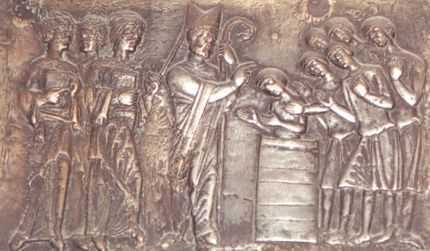
Reserved Area
Artists - ArtWorks
The Gniezno Door
 Poland
PolandArchitecture and Roman Art
The Gniezno Door/ the door of the cathedral in Gniezno
Probably 1175. year
The deep crisis and efforts made to reconsolidate the Polish State after Boleslaw Chrobry’s death till the period of Boleslaw Krzywousty’s reigning. Poland appeared in the reality of the division into separate districts. The introduction of Christianity into Poland, the process of Christianization in Prussia meant Poland’s inclusion into the family of the Western Europe’s civilization. Introduction of Latin language which was the strong factor joining culturally and historically Poland with the West of Europe.
St. Frank from Assigi, St. Thomas from Aquinas Gall Anonim, Jan Dlugosz, St. Augustine, Bernard from Clairvaux, Wincenty Kadlubek, Przeclaw Słota
Middle Ages- Gothic and Roman Styles took their patterns from the Byzantine Style, there were seen the influences of the barbarian tribes hording from the Eastern outskirts of Europe. The included Postmodernism reflected the local tradition and imitated the historic plots.
ST Adalbert was a moral pattern for the people, according to the author’s considerations. He was a sufferer in the name of God and religion, admittedly he was a person worth following by others. His life’ scenes ideally matched with the church door. The door’s scenery subconsciously draws our attention from the very initial moment. It could be a suggested analogy with the gate opening the Paradise. The author wanted to emphasize the importance of the St. Adalbert’s mission and heroism just in the Capital of Poland of that time, the most important national centre as regards our culture, economy and political decisions.
"Door of Paradise" (made in the years: 1425-1450) in the Babtize House in Florence is located on the Eastern side of the building. The masterpiece was made by Lorenzo Ghiberti. There were presented on it the Old Testimony’s scenes, glorified the Biblical characters and were purposely introduced artists of that period themselves. The door expressed a deep religious contribution and a readable emphasis of the faith’s connection remaining steady with the path of the required moral order. That order was signified as being permanent, unchangeable, crossing naturally the epochs’ frames. We can find the same ideology and the moral demonstration regardless of time and the national source.
Primarily, the door was divided into 18 rectangular quarters, 9 units on either wing. There were demonstrated and glorified the scenes concerning St. Adalbert’s life. The scenes were surrounded pathetically by the bordures in which there were interwoven motives of decorative trees’ branches and the human and animal motives.
The artistic convention is concentration on the religion’s notion in every person’s life. It proves to be a fundamental feature of the considered period, because the represented scenes had a significant importance and influence many people’s reality and their code of values. The religious motive was the mainstream point of consideration, which beyond all doubts focused the Middle Ages people’s mentality and moral self- constitution.
Mare Balticum. Herausgegeben von Dietmar Albrecht und Martin Thoemmes. München: Meidenbauer, Februar 2005 (Colloquia Baltica 1).
Z. Świechowski, Sztuka romańska, Warszawa 2005
Źródło: "http://pl.wikipedia.org/wiki/Drzwi_Gnie%C5%BAnie%C5%84skie"
http://www.zjazd.eu/zjazd/drzwi.html
http://www.drzwi-gnieznienskie-pl.com/
http://www.zgapa.pl/zgapedia/Drzwi_Gnie%C5%BAnie%C5%84skie.html
http://dziedzictwo.ekai.pl/@@gniezno_drzwi_gnieznienskie
Related Material:
Image available

File name: 36_Fragment drzwi gnieźnieńskich.jpg
Description of the material:
(Source 1) The material gives a compound scope of information related to the artistic artifacts of the epoch. The material shows descriptions of the masterpieces and their historic interpretations. (Source 2) The source opens the door of the Polish art's timeline, calendar and orders the components in the functional, observable sequence.
Contextualisation Of the source:
(Source 1) The context of the source is combined with the national heritage, its systemic exploration and the patterns enlightening understanding symbols, figures, metaphors. (Source 2) The context of the source is to show the effects of artistic continuity and glorifying the language of art as the advocacy of the Polish culture. http://pl.wikipedia.org/wiki/Drzwi_Gnie%C5%BAnie%C5%84skie http://www.polskiedzieje.pl/galeria-historyczna/obraz-duzy-381
Interpretation of the source:
(Source 1) The source is dedicated to specyfic artistic initiations and phenomena- crucial for the Polish culture's exploration. The thematic notions are regarded as the basis points set in the sequence of the progress of the artistic visions and schedules. (Source 2) The source can be interpretated as the horizons and frames encompassing of the Polish culture, understood in the categories of revealing our national heritage and its worked out positioned patterned elaboration. The most important events, ceremonies, rituals are projected here in the disguise of the artistic costume and splendour.
Comments about this Artist/ArtWork
Michelangelo - Copyright 2008 - This project has been funded with support from the European Commission